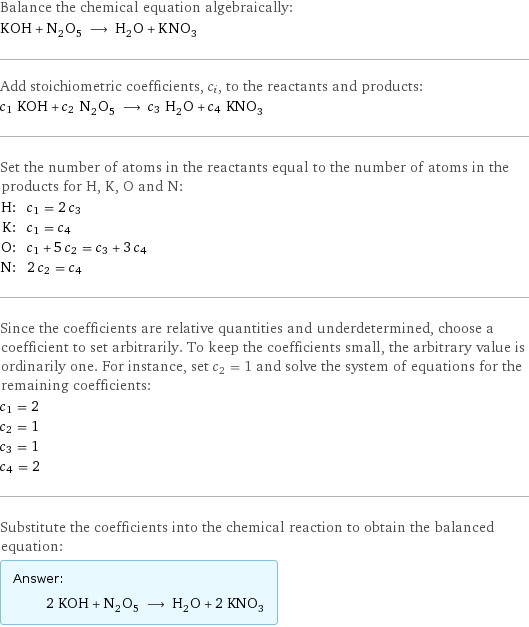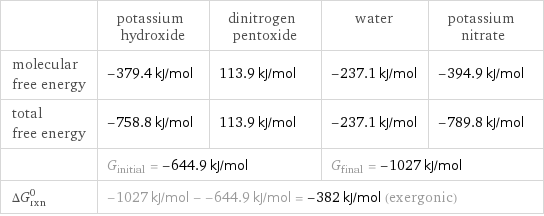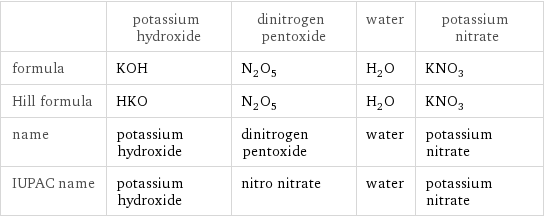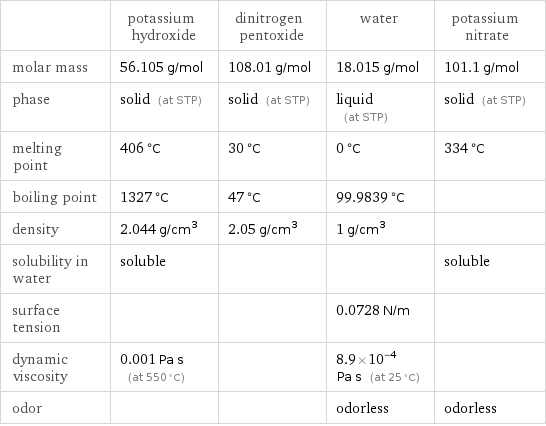Input interpretation

KOH potassium hydroxide + N_2O_5 dinitrogen pentoxide ⟶ H_2O water + KNO_3 potassium nitrate
Balanced equation

Balance the chemical equation algebraically: KOH + N_2O_5 ⟶ H_2O + KNO_3 Add stoichiometric coefficients, c_i, to the reactants and products: c_1 KOH + c_2 N_2O_5 ⟶ c_3 H_2O + c_4 KNO_3 Set the number of atoms in the reactants equal to the number of atoms in the products for H, K, O and N: H: | c_1 = 2 c_3 K: | c_1 = c_4 O: | c_1 + 5 c_2 = c_3 + 3 c_4 N: | 2 c_2 = c_4 Since the coefficients are relative quantities and underdetermined, choose a coefficient to set arbitrarily. To keep the coefficients small, the arbitrary value is ordinarily one. For instance, set c_2 = 1 and solve the system of equations for the remaining coefficients: c_1 = 2 c_2 = 1 c_3 = 1 c_4 = 2 Substitute the coefficients into the chemical reaction to obtain the balanced equation: Answer: | | 2 KOH + N_2O_5 ⟶ H_2O + 2 KNO_3
Structures

+ ⟶ +
Names

potassium hydroxide + dinitrogen pentoxide ⟶ water + potassium nitrate
Reaction thermodynamics
Enthalpy

| potassium hydroxide | dinitrogen pentoxide | water | potassium nitrate molecular enthalpy | -424.6 kJ/mol | -43.1 kJ/mol | -285.8 kJ/mol | -494.6 kJ/mol total enthalpy | -849.2 kJ/mol | -43.1 kJ/mol | -285.8 kJ/mol | -989.2 kJ/mol | H_initial = -892.3 kJ/mol | | H_final = -1275 kJ/mol | ΔH_rxn^0 | -1275 kJ/mol - -892.3 kJ/mol = -382.7 kJ/mol (exothermic) | | |
Gibbs free energy

| potassium hydroxide | dinitrogen pentoxide | water | potassium nitrate molecular free energy | -379.4 kJ/mol | 113.9 kJ/mol | -237.1 kJ/mol | -394.9 kJ/mol total free energy | -758.8 kJ/mol | 113.9 kJ/mol | -237.1 kJ/mol | -789.8 kJ/mol | G_initial = -644.9 kJ/mol | | G_final = -1027 kJ/mol | ΔG_rxn^0 | -1027 kJ/mol - -644.9 kJ/mol = -382 kJ/mol (exergonic) | | |
Equilibrium constant
![Construct the equilibrium constant, K, expression for: KOH + N_2O_5 ⟶ H_2O + KNO_3 Plan: • Balance the chemical equation. • Determine the stoichiometric numbers. • Assemble the activity expression for each chemical species. • Use the activity expressions to build the equilibrium constant expression. Write the balanced chemical equation: 2 KOH + N_2O_5 ⟶ H_2O + 2 KNO_3 Assign stoichiometric numbers, ν_i, using the stoichiometric coefficients, c_i, from the balanced chemical equation in the following manner: ν_i = -c_i for reactants and ν_i = c_i for products: chemical species | c_i | ν_i KOH | 2 | -2 N_2O_5 | 1 | -1 H_2O | 1 | 1 KNO_3 | 2 | 2 Assemble the activity expressions accounting for the state of matter and ν_i: chemical species | c_i | ν_i | activity expression KOH | 2 | -2 | ([KOH])^(-2) N_2O_5 | 1 | -1 | ([N2O5])^(-1) H_2O | 1 | 1 | [H2O] KNO_3 | 2 | 2 | ([KNO3])^2 The equilibrium constant symbol in the concentration basis is: K_c Mulitply the activity expressions to arrive at the K_c expression: Answer: | | K_c = ([KOH])^(-2) ([N2O5])^(-1) [H2O] ([KNO3])^2 = ([H2O] ([KNO3])^2)/(([KOH])^2 [N2O5])](../image_source/71c49fb6bcc4a14e8e71f6e3864f6a17.png)
Construct the equilibrium constant, K, expression for: KOH + N_2O_5 ⟶ H_2O + KNO_3 Plan: • Balance the chemical equation. • Determine the stoichiometric numbers. • Assemble the activity expression for each chemical species. • Use the activity expressions to build the equilibrium constant expression. Write the balanced chemical equation: 2 KOH + N_2O_5 ⟶ H_2O + 2 KNO_3 Assign stoichiometric numbers, ν_i, using the stoichiometric coefficients, c_i, from the balanced chemical equation in the following manner: ν_i = -c_i for reactants and ν_i = c_i for products: chemical species | c_i | ν_i KOH | 2 | -2 N_2O_5 | 1 | -1 H_2O | 1 | 1 KNO_3 | 2 | 2 Assemble the activity expressions accounting for the state of matter and ν_i: chemical species | c_i | ν_i | activity expression KOH | 2 | -2 | ([KOH])^(-2) N_2O_5 | 1 | -1 | ([N2O5])^(-1) H_2O | 1 | 1 | [H2O] KNO_3 | 2 | 2 | ([KNO3])^2 The equilibrium constant symbol in the concentration basis is: K_c Mulitply the activity expressions to arrive at the K_c expression: Answer: | | K_c = ([KOH])^(-2) ([N2O5])^(-1) [H2O] ([KNO3])^2 = ([H2O] ([KNO3])^2)/(([KOH])^2 [N2O5])
Rate of reaction
![Construct the rate of reaction expression for: KOH + N_2O_5 ⟶ H_2O + KNO_3 Plan: • Balance the chemical equation. • Determine the stoichiometric numbers. • Assemble the rate term for each chemical species. • Write the rate of reaction expression. Write the balanced chemical equation: 2 KOH + N_2O_5 ⟶ H_2O + 2 KNO_3 Assign stoichiometric numbers, ν_i, using the stoichiometric coefficients, c_i, from the balanced chemical equation in the following manner: ν_i = -c_i for reactants and ν_i = c_i for products: chemical species | c_i | ν_i KOH | 2 | -2 N_2O_5 | 1 | -1 H_2O | 1 | 1 KNO_3 | 2 | 2 The rate term for each chemical species, B_i, is 1/ν_i(Δ[B_i])/(Δt) where [B_i] is the amount concentration and t is time: chemical species | c_i | ν_i | rate term KOH | 2 | -2 | -1/2 (Δ[KOH])/(Δt) N_2O_5 | 1 | -1 | -(Δ[N2O5])/(Δt) H_2O | 1 | 1 | (Δ[H2O])/(Δt) KNO_3 | 2 | 2 | 1/2 (Δ[KNO3])/(Δt) (for infinitesimal rate of change, replace Δ with d) Set the rate terms equal to each other to arrive at the rate expression: Answer: | | rate = -1/2 (Δ[KOH])/(Δt) = -(Δ[N2O5])/(Δt) = (Δ[H2O])/(Δt) = 1/2 (Δ[KNO3])/(Δt) (assuming constant volume and no accumulation of intermediates or side products)](../image_source/cd67065e0a5b42c36b764eea44ac0a2d.png)
Construct the rate of reaction expression for: KOH + N_2O_5 ⟶ H_2O + KNO_3 Plan: • Balance the chemical equation. • Determine the stoichiometric numbers. • Assemble the rate term for each chemical species. • Write the rate of reaction expression. Write the balanced chemical equation: 2 KOH + N_2O_5 ⟶ H_2O + 2 KNO_3 Assign stoichiometric numbers, ν_i, using the stoichiometric coefficients, c_i, from the balanced chemical equation in the following manner: ν_i = -c_i for reactants and ν_i = c_i for products: chemical species | c_i | ν_i KOH | 2 | -2 N_2O_5 | 1 | -1 H_2O | 1 | 1 KNO_3 | 2 | 2 The rate term for each chemical species, B_i, is 1/ν_i(Δ[B_i])/(Δt) where [B_i] is the amount concentration and t is time: chemical species | c_i | ν_i | rate term KOH | 2 | -2 | -1/2 (Δ[KOH])/(Δt) N_2O_5 | 1 | -1 | -(Δ[N2O5])/(Δt) H_2O | 1 | 1 | (Δ[H2O])/(Δt) KNO_3 | 2 | 2 | 1/2 (Δ[KNO3])/(Δt) (for infinitesimal rate of change, replace Δ with d) Set the rate terms equal to each other to arrive at the rate expression: Answer: | | rate = -1/2 (Δ[KOH])/(Δt) = -(Δ[N2O5])/(Δt) = (Δ[H2O])/(Δt) = 1/2 (Δ[KNO3])/(Δt) (assuming constant volume and no accumulation of intermediates or side products)
Chemical names and formulas

| potassium hydroxide | dinitrogen pentoxide | water | potassium nitrate formula | KOH | N_2O_5 | H_2O | KNO_3 Hill formula | HKO | N_2O_5 | H_2O | KNO_3 name | potassium hydroxide | dinitrogen pentoxide | water | potassium nitrate IUPAC name | potassium hydroxide | nitro nitrate | water | potassium nitrate
Substance properties

| potassium hydroxide | dinitrogen pentoxide | water | potassium nitrate molar mass | 56.105 g/mol | 108.01 g/mol | 18.015 g/mol | 101.1 g/mol phase | solid (at STP) | solid (at STP) | liquid (at STP) | solid (at STP) melting point | 406 °C | 30 °C | 0 °C | 334 °C boiling point | 1327 °C | 47 °C | 99.9839 °C | density | 2.044 g/cm^3 | 2.05 g/cm^3 | 1 g/cm^3 | solubility in water | soluble | | | soluble surface tension | | | 0.0728 N/m | dynamic viscosity | 0.001 Pa s (at 550 °C) | | 8.9×10^-4 Pa s (at 25 °C) | odor | | | odorless | odorless
Units
